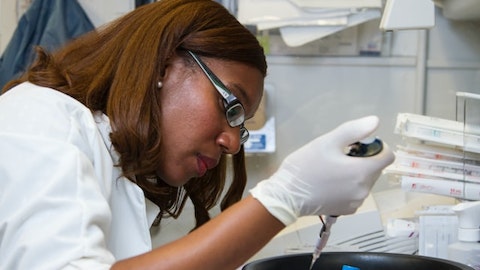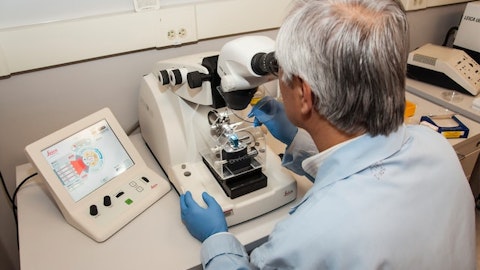So that’s sort of the three hypotheses. In terms of the data what we’re looking for is want to see a high level of responses in these patients. We want to see whether these responses get deep over time, usually depending on what you need to score for, can take a bit of time to develop fully. And secondly, we want to see the cellular dynamics of the products in the patients as a consequence of adding the CD19 component to the product. So those are probably the key things. And I think once we have that data in and with a reasonable number of patients backing it, I think that’s been the time for us to sort of think about the approach that would be suitable for the development for the program going forward. But in terms of the hurdle for development, clearly you need to have an exceptional profile of the product to develop that in multi myeloma.
So that’s sort of where we are and our current thinking is.
Gil Blum: Makes sense. I do want to go back to a point that you made during the SLE event. So why does the company believe that other commercial stage CAR T’s would need to maybe redo their production and do more clinical studies in order to move into SLE despite the fact that they already have commercial stage assets?
Christian Itin: That’s a really good question. And I think what we’re seeing with two programs that are being moved forward is that the companies decided to massively change their manufacturing. So in one case it’s moving from a manual, very lengthy manufacturing process to a highly automated, probably two day process. That’s a massive change in terms of the actual manufacturing process. It will lead to, frankly, different products. And particularly if you go to this very early stage or very short manufacturing process, you run the additional issue that at that point in time, the CARs, the chimeric antigen receptors are not yet expressed properly on the surface. And with that, the cells are not yet functional, biologically functional from a potency perspective or an ability to kill other cells perspective.
So it creates clearly a very, very different type of product, different set of product properties. And with that you have a new product and that means that you have to obviously redo or generate new clinical safety data, et cetera, build that database. And from a commercial manufacturing base, it’s a fundamentally different setup from the manual setup, which requires, as an example, a high grade clean room environment versus the semi or the automated platform as we use it, where you basically go to a low grade clean room environment. So it’s a very different environment to be optimal. The way you have the flows in a facility and be optimal for that from a cost perspective looks different. And we would expect it will require pretty significant investments to actually change or build new manufacturing facilities to sort of accommodate this very different manufacturing process.
The second company in this space also has made very significant changes, calls the product differently as well in terms of its coding. And we do not believe that the product will be comparable. And there’s also going to be certainly some level of adjustment that will have to be made to the commercial manufacturing infrastructure. To adjust to the new process and trying to be effective with a decision with it. So those are probably some of the key considerations. What they obviously do have is the base set of systems for commercialization to a cell orchestration and so on. That’s obviously straight, usable and can be straight applied. So there is clearly an advantage there of being able to rely on that as we will rely on the systems we’re setting up now for ALM.
Gil Blum: All right, thanks for taking my questions.
Christian Itin: Thanks a lot, Gil.
Operator: One moment for our next question. Our next question comes from the line of Yanan Zhu of Wells Fargo. Your line is now open.
Yanan Zhu: Hi, thanks. Thanks for taking our questions. I have a couple for the SLE and a couple for FELIX. Perhaps let’s start with the SLE. I was wondering, Christian, you were talking about the benefit of us having – one of the benefits of having the same product as your other soon-to-be commercial product is that may be discharged of some of the safety database size requirements in your new indication. I was just wondering is that something that you have had some preliminary agreements with the agencies on? Or is that your general expectation? Also, I was wondering if you have any thoughts on Novartis’ YTB323 abstracts at ACR? Any comment on their dose level early efficacy and also early safety? And how – does that have any implication for your confidence for obe-cel in SLE? And I’ll ask the FELIX question afterwards. Thanks.
Christian Itin: Okay. Well, thanks, Yanan, for joining. Really good questions. So first off, on the safety. Also, this is based on sort of the regulatory guidance you have in terms of the general size of safety databases to get after discharge, the respective level of risk. And that’s actually consistent when you look at the various indications and the way you can actually use information gained in one indication applied to another for as long as you’re working with the same product. So this is not specific guidance. This is the general guidance that you have in terms of safety requirements and discharging safety business. The second aspect – a second part of the question was related to the abstract from the Novartis’ program, which I think things look good.




